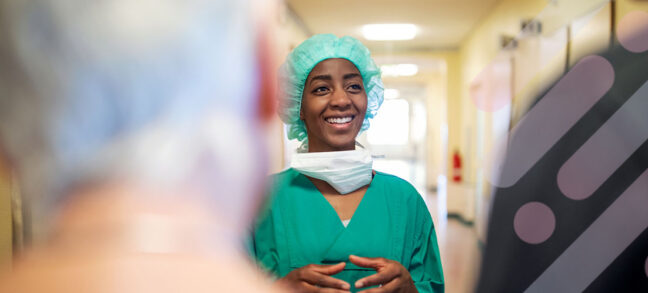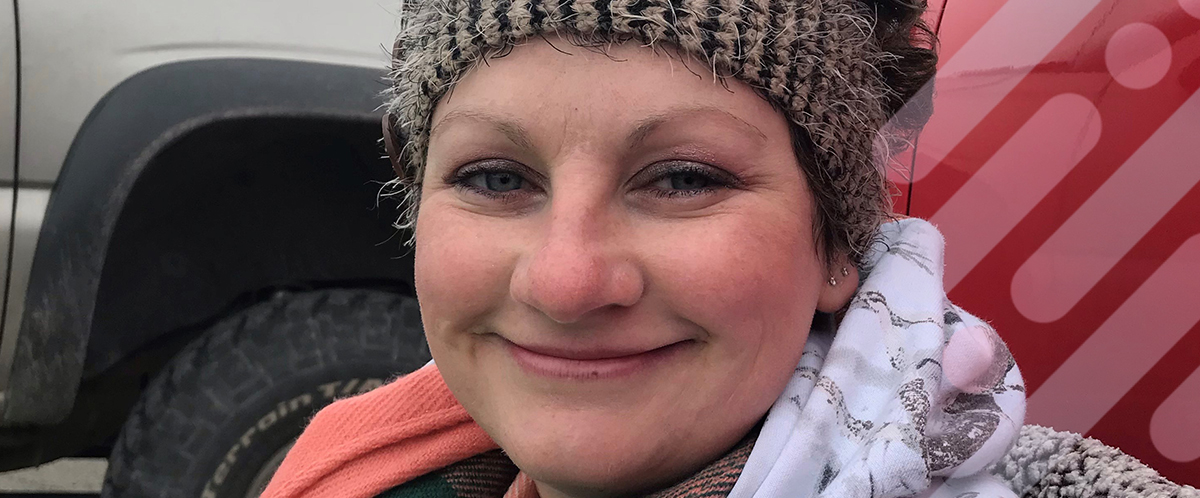Stephanie is a vibrant, engaging woman soaking up life in a small town in Texas. She’s been married to her junior high sweetheart for 18 years and working in the finance industry for the same amount of time.
“We have no kids, but we have a little Jack Russell named Watson. That’s our kiddo.”
She loves to garden, cook and hang out with family and friends.
Stephanie’s normal, full life experienced a hiccup one morning that set her down a path of misdiagnosis, endless monitoring and more questions than solutions.
sudden symptoms, but no answers
On what started like any other day in 2015, Stephanie stepped out of the shower and began to dry off.
No matter how much she dried off, she noticed that her breast was still wet. “And then I realized it was actually coming from my nipple. My left breast was leaking a clear fluid. It was not milk. It was just a clear liquid, it almost looked like water. So, I called my OB-GYN and that next day I had a sonogram. Everything looked fine.”
She had an MRI, CT scans, a mammogram sonogram—and everything came back fine.
Stephanie next met with an endocrinologist to check her hormone levels. After performing a full panel, everything came back fine. “I wasn’t very happy with that answer … because I was like, there’s something that’s obviously happening if my body is doing that.”
Another physician recommended that Stephanie take a blocking medication to make her body stop producing milk, because they were very confident that’s what her body was producing, even though it didn’t look like milk.
So, Stephanie went back to her general practitioner to get a third opinion on it, and he sent her to a breast specialist where she had an MRI, CT scans, a mammogram sonogram—and everything came back normal. Stephanie was put on a six-month watch period to monitor symptoms.
too young for all that
“And six months later, I had everything rechecked. Everything was still fine, nothing present. So, I was told to continue to monitor. I was actually told that ‘leaky breasts sometimes just happen.’ I heard that probably from three or four different people.”
Stephanie continued to wait and monitor for new or unexplained symptoms, at which point she started to have rheumatoid arthritis and joint problems. With autoimmune issues happening at the same time, most of the doctors she saw said she was too young to have all of these things happening to her.
“They kind of started to brush off my symptoms a little bit,” Stephanie said. “I was angry. I think the part that made me the most angry is that it does not matter your age—if you have lived in your body and you are familiar with your body and how it works, and if something is not functioning properly or appropriately and you know something is wrong, continue to hunt until you find the answers.”
“I understand that I’m young, but I also understand that my body is hurting and something’s wrong with it.”
And so, in 2017 Stephanie changed physicians completely, and got a brand-new general practitioner. “I was not getting answers that I wanted. And I thought a clean slate with a new general practitioner and seeing a whole new set of doctors would be helpful.”
Stephanie went in with a list of all of the symptoms she had and said, “’I am too young to be having all these problems, but something is wrong. And he actually circled my breast leaking symptom as issue number one.”
He sent Stephanie to a breast specialist who he knew and trusted to get her opinion.
an answer at last
“I remember her doing a sonogram. And this was one of the things that really set her apart. All other specialists I saw had outsourced everything to somebody else. But she is the one who did the sonogram, and she is the one who used all of the tools to really get in there and find out what she was looking for. And one of the things that she had commented on is a huge cyst in my breast. She said, ‘This cyst is so big, it looks like a breast implant, but I know you don’t have a breast implant in here… it’s amazing how large this is.’”
“And that day, she took a sample of fluid, which was a green color. That was really disgusting. It was like the slimy monster from “Ghostbusters” color green. And she told me that was not a good sign, but not to freak out.”
“Within 12 hours, she diagnosed me.”
She did a biopsy that day and rushed the results.
“Within 12 hours, she diagnosed me initially with stage three breast cancer,” Stephanie says.
It turns out, Stephanie wasn’t too young for a diagnosis.
hitting the ground running
Stephanie was shocked, but she had never been a person that takes bad news without putting up a fight.
“She was very blunt and told me that if I did not go the route of chemo, I would be dead very soon.”
“I honestly went into fight mode pretty quickly. I felt very behind. I like to understand and research, so the first thing I did is buy as many books as I could to educate myself on beating breast cancer, whether through diet, nutrition, incorporating people in my life to be supportive,” Stephanie said. “I ended up working with a nutritionist. I worked with massage therapists to get my body ready for surgery.”
“When I first met with my oncologist, she said my only option was chemo, radiation and mastectomy. She recommended a single mastectomy at the time and then going through radiation. And I had asked her about more holistic or alternative therapies. She was very blunt and told me that if I did not go the route of chemo, I would be dead very soon.”
When it came time to fight, Stephanie was ready. She went through 16 rounds of chemo and 25 rounds of radiation.
When it was time for her mastectomy, it was her surgeon who suggested she consider Resensation.
regaining sensation, regaining self
Stephanie opted for DIEP flap reconstruction along with a bilateral mastectomy rather than a single, to make sure all her bases were covered.
Prior to her surgery, Stephanie’s surgeon asked her if she would be interested in Resensation. The concept of numbness after mastectomy hadn’t crossed her mind, so she was intrigued by the idea possibly regaining her sense of touch. After talking about the process and coming to a better understanding of what was involved, Stephanie was all in.
“It worked out very well for me. I have [regained] probably about 80% sensation in my chest.”
“Being able to feel a hug is a big deal.”
Stephanie’s decision to opt for Resensation surgery was the right call for her. “Now there’s still a few little areas that I can feel pressure, but I can’t really feel the sensation itself. But it feels like something’s there, which is comforting,” Stephanie said. “And what that’s meant for me is … it’s giving somebody a hug and being able to feel that hug. It’s a big deal, you know? It’s amazing to be able to embrace somebody in a good hug and just feel that pressure on your chest. Or being able to hold a kid or an animal and feel the sensation.”
Thanks to Resensation, Stephanie has comfort in knowing she can also feel the clothing on her chest, and if it’s starting to shift a little out of line. “I do a lot of public speaking, and when you’re standing in front of a room and you can’t tell where your clothing is, that’s a really odd feeling. You want to constantly look down and like, check yourself just to make sure that everything’s OK.”
a new outlook
Stephanie sees things differently now. And she thinks that’s a good thing.
“There is life after cancer. It does look different. I think a lot of people do try to get back to as normal as you can, but you’re never really the same after cancer. You learn a lot about yourself and how strong you are,” Stephanie said.
“Life looks a lot different after cancer—in a positive way.”
“I enjoy life a lot more than I did before. Cancer just puts a much different marker [on your life]. When you get told that you potentially have six months to a year to live and then you overcome it. Then it’s like, OK, I’ve got a little bit more time left.”
Some links will navigate you away from the Resensation® website. Links outside of resensation.com are provided as a resource to the viewer, and do not constitute an endorsement or recommendation by Axogen. Axogen accepts no responsibility for or control over the content of the linked sites.
*The level of sensation restored following use of the Resensation technique may vary and cannot be guaranteed, due to unique anatomy and other considerations. Please consult a surgeon for more detailed information.
Each patient outcome is dependent upon the nature and extent of nerve loss or damage, the timing between nerve loss and repair, and the natural course of the patient’s recovery. These testimonials reflect the experience of the particular individual and may not represent typical results.
Some links will navigate you away from the Resensation® website. Links outside of resensation.com are provided as a resource to the viewer, and do not constitute an endorsement or recommendation by Axogen. Axogen accepts no responsibility for or control over the content of the linked sites.
Resensation Blog

How does mastectomy impact the nerves in the breast?
One sometimes overlooked aspect of mastectomy is its impact on nerves. Read what happens to nerves during mastectomy and explore…
Read More
What happens during implant breast reconstruction with Resensation®?
By repairing sensory nerves, Resensation® enables you to potentially regain sensation to your chest. Read how this procedure works during…
Read More
how resensation® helped Leanna feel secure in her family’s future
With Resensation®, Leanna can be there to watch her kids grow up—without losing the feeling of being whole.
Read More
sensory retraining: what is it, and how can it help me after resensation®?
Sensory retraining is a series of exercises designed to help you reconnect with your body after breast reconstruction with Resensation®.
Read More